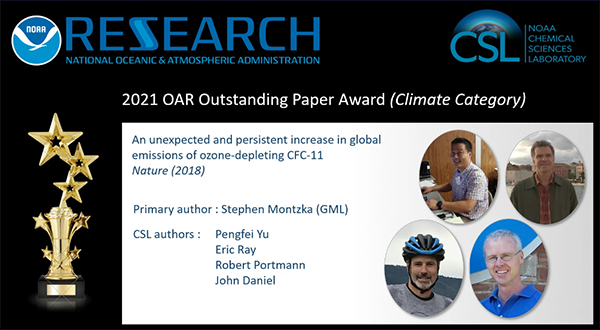A .gov website belongs to an official government organization in the United States.
A lock () or https:// means you've safely connected to the .gov website. Share sensitive information only on official, secure websites.
14 March 2022

GML and CSL authors receive the 2021 NOAA OAR Outstanding Scientific Paper Award in the category of Climate.
This selected paper announced the first substantial violation of the Montreal Protocol on Substances that Deplete the Ozone Layer. It furthermore demonstrated that a portion of this violation arose in eastern Asia. These conclusions were drawn from the detection of very small changes in the rate of change, distribution, and variability in atmospheric concentrations of CFC-11 precisely measured at multiple sites across the globe. These changes pointed to increased emissions of a major ozone-depleting chemical that had been banned from use since 2010.
Since this paper was published, substantial follow-up and scientific work has been initiated, including studies to investigate the implications for ozone layer recovery, and to search for evidence of other violations of the Protocol. While the substantial citation metrics reflect the magnitude of follow-up studies and discussions, it is also worth pointing out that the two main advisory panels of the Parties to the Montreal Protocol convened scientific meetings in Vienna devoted entirely to the findings of this paper and have or will publish major reports describing the causes and impacts of the illicit CFC-11 production and emission. China also held an international workshop on the issue in Beijing in March of 2019, and has devised a multipoint plan to ensure rapid resolution of the CFC-11 issue and improve/develop their own capabilities for detecting illicit activities in future.
The findings of the paper are directly relevant to the NOAA mission "To understand and predict changes in climate, weather, oceans and coasts" as applied research because they relate to characterizing and understanding unexpected changes in atmospheric composition that are relevant to climate, given that CFC-11 and stratospheric ozone are greenhouse gases. The results are also important to the ocean as ozone depletion increases the flux of harmful UV radiation to the oceanic biosphere. The findings enable better predictions of future UV exposure and climate as they refine our understanding of future trajectories for both CFC-11 and stratospheric ozone given the apparent lack of compliance with the Montreal Protocol.
Another important component of NOAA's mission is "To share that knowledge and information with others." Because of the global interest in the issue of ozone depletion and the Montreal Protocol, a substantial associated communication effort was made by the authors to share the results with multiple stakeholders both nationally and internationally, including the public, fellow scientists, industry experts, representatives from other U.S. government agencies (Department of State, U.S. EPA, Department of Agriculture, U.S. Congressional staff), and the Parties to the Montreal Protocol (representatives of all nations of the world).
The paper is recognized by Craig McLean, NOAA OAR Assistant Administrator, and Gary Matlock, NOAA OAR Deputy Assistant Administrator for Science, at the NOAA Outstanding Scientific Paper Awards virtual seminar held on March 14.
Montzka, S.A., G.S. Dutton, P. Yu, E. Ray, R. Portmann, J.S. Daniel, L. Kuijpers, B.D. Hall, D. Mondeel, C. Siso, D. Nance, M. Rigby, A. Manning, L. Hu, F. Moore, B.R. Miller, and J.W. Elkins, An unexpected and persistent increase in global emissions of ozone-depleting CFC-11, Nature, doi:10.1038/s41586-018-0106-2, 2018.
The Montreal Protocol was designed to protect the stratospheric ozone layer by enabling reductions in the abundance of ozone-depleting substances such as chlorofluorocarbons (CFCs) in the atmosphere. The reduction in the atmospheric concentration of trichlorofluoromethane (CFC-11) has made the second-largest contribution to the decline in the total atmospheric concentration of ozone-depleting chlorine since the 1990s. However, CFC-11 still contributes one-quarter of all chlorine reaching the stratosphere, and a timely recovery of the stratospheric ozone layer depends on a sustained decline in CFC-11 concentrations. Here we show that the rate of decline of atmospheric CFC-11 concentrations observed at remote measurement sites was constant from 2002 to 2012, and then slowed by about 50 per cent after 2012. The observed slowdown in the decline of CFC-11 concentration was concurrent with a 50 per cent increase in the mean concentration difference observed between the Northern and Southern Hemispheres, and also with the emergence of strong correlations at the Mauna Loa Observatory between concentrations of CFC-11 and other chemicals associated with anthropogenic emissions. A simple model analysis of our findings suggests an increase in CFC-11 emissions of 13 ± 5 gigagrams per year (25 ± 13 per cent) since 2012, despite reported production being close to zero since 2006. Our three-dimensional model simulations confirm the increase in CFC-11 emissions, but indicate that this increase may have been as much as 50 per cent smaller as a result of changes in stratospheric processes or dynamics. The increase in emission of CFC-11 appears unrelated to past production; this suggests unreported new production, which is inconsistent with the Montreal Protocol agreement to phase out global CFC production by 2010.